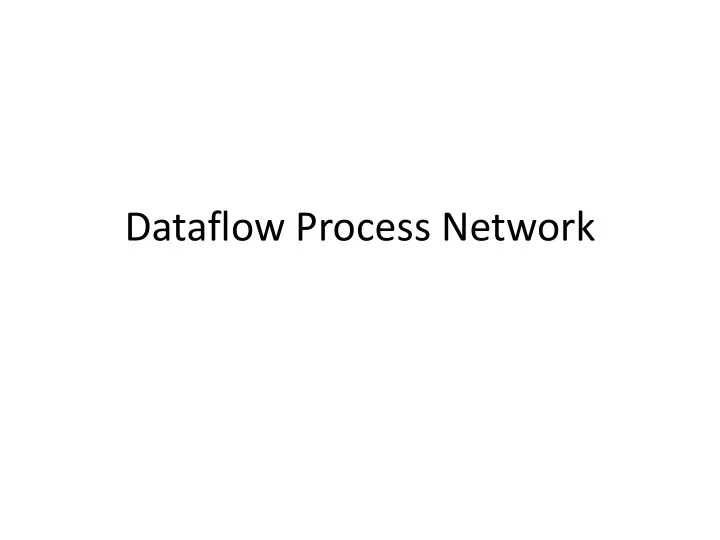

Dataflow Process Network
Goals • Formalize dataflow process network – Widely used in signal processing community – SPW, COSSAP, Khoros, Ptolemy, etc • Good basis for programming language – Hierarchy, higher order function, recursion, etc
Kahn Process Networks • MoC where concurrent processes communicate through unidirectional FIFO • Process – Maps one or more input sequences to one or more output sequences – Usually constrained to be continuous • F(sup X) = sup F(X)
Dataflow Process Networks • A process is sequence of firings of dataflow actors – F = map(f) • Actor – Fires according to firing rules – Each firing consumes input tokens and produces output tokens • Continuity – Functional • No side effects – Sequential • Firing rules can be tested in a predefined ordering
Firing Rules • An actor with p inputs – N firing rules: R = {R 1 , R 2 , …, R N } – Patterns for each input: R i = {R i,1 , R i,2 , …, R i,p } • In order to fire – The patterns must be a prefix of the tokens at the inputs – Adder: R 1 = {[*], [*]} – Select: R 1 = {[*], [], [T]}, R 2 = {[], [*], [F]}
Execution Model • Concurrent processes – Demand driven style – Processes with unavailable inputs are put to sleep with its input channels marked hungry – Writing to hungry channel suspends the writer and wakes the waiter • Static/dynamic scheduling – Possible in dataflow process network b/c of actors – Avoids overhead of context switching • Tagged-token model – Each token has a tag – Fire only when input tokens have matching tags – No need for FIFO, tags impose order
Language Design • Ptolemy as a driving example – Visual and textual interface – No built in MoC – Supports 3 different dataflow process network domains – Extensible set of primitive actors
Hierarchy • Subgraphs can be encapsulated into a single node • Difficulties – Want hierarchical nodes to have the same properties as primitives • Firing rules, functional, etc. • State introduced from self loops on primitive actors – Reconciled: state is syntactic sugar for delay
Function Arguments • Two types of arguments – Parameters – Input streams • Why the distinction? – Parameters are constants – Do not need arcs for parameters – Simplifies work done by compiler/interpreter
Recursion • Two examples – Sieve of Eratosthenes – FFT • Sieve of Erathosthenes – Implemented with a hierarchical node “sift” that invokes itself when called – Graph is dynamically expanded • Mutates during execution • FFT – Contrast to sieve of Erasthosthenes – Can be completely scheduled at compile time
Higher Order Function • Map actor – Inputs: • Blockname • Input_map • Output_map – Replaces itself with one or more instances of the specified actor • IfThenElse – Takes two replacement actors and a predicate
Datatypes, polymorphism • Networks are typed – Type consistency is statically checked • Polymorphism – Ptolemy supports parametric and ad-hoc • Parametric: behaves same way regardless of data type • Ad-hoc: behavior can be different
Parallelism • Comes for free in dataflow process network – Dataflow graph exposes parallelism for hardware or compiler – Recursion can be evaluated during setup phase
Conclusion • Formalization was useful
Recommend
More recommend